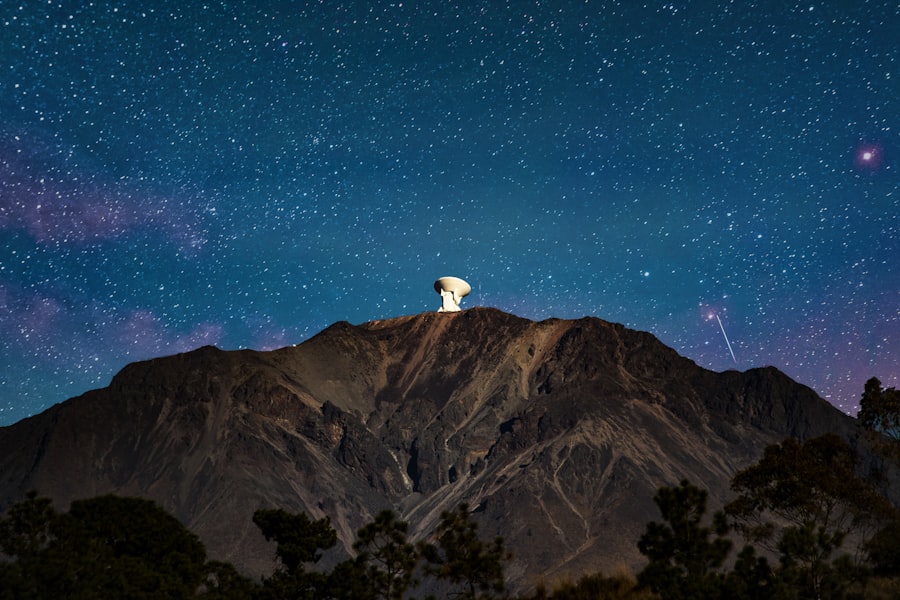Space telescopes represent a monumental leap in our quest to understand the cosmos. Unlike their ground-based counterparts, which are hindered by atmospheric interference, space telescopes operate beyond the Earth’s atmosphere, allowing for clearer and more detailed observations of celestial phenomena. The concept of placing telescopes in orbit was born out of necessity; the atmosphere distorts light from distant stars and galaxies, creating a veil that obscures our view.
By positioning telescopes in space, astronomers can bypass these limitations, capturing images and data that are far more precise and revealing. The first successful space telescope, the Hubble Space Telescope, was launched in 1990 and has since transformed our understanding of the universe. Hubble’s ability to observe in various wavelengths—from ultraviolet to near-infrared—has provided insights into the formation of stars, the nature of black holes, and the expansion of the universe itself.
Following Hubble, several other space telescopes have been developed, each designed with specific scientific goals in mind. These instruments not only enhance our observational capabilities but also inspire a new generation of scientists and enthusiasts eager to explore the mysteries of the universe.
Key Takeaways
- Space telescopes are powerful instruments that observe the universe from outside Earth’s atmosphere, providing clearer and more detailed images of celestial objects.
- Space telescopes work by capturing light and other forms of electromagnetic radiation from space, and then transmitting the data back to Earth for analysis.
- The impact of space telescopes on astronomy has been profound, revolutionizing our understanding of the universe and leading to numerous groundbreaking discoveries.
- Space telescopes have made significant discoveries, including the detection of exoplanets, the study of distant galaxies, and the observation of cosmic phenomena such as black holes and supernovae.
- The future of space telescopes holds promise for even more advanced instruments, but also presents challenges such as funding and technological limitations. International collaboration is crucial for the success of space telescope research and for unveiling the mysteries of the universe.
How Space Telescopes Work
The fundamental operation of space telescopes hinges on their ability to collect and analyze light from astronomical objects. At their core, these telescopes utilize mirrors and lenses to gather light and focus it onto detectors. The design of these optical systems is critical; for instance, Hubble employs a large primary mirror that captures light from distant sources and reflects it to a secondary mirror, which then directs the light to scientific instruments.
This configuration allows for high-resolution imaging and spectroscopy, enabling astronomers to dissect the light from stars and galaxies into its constituent wavelengths. In addition to optical components, space telescopes are equipped with advanced detectors that convert incoming light into electronic signals. These detectors can be sensitive to various wavelengths, including visible light, infrared, and ultraviolet.
For example, the James Webb Space Telescope (JWST), launched in December 2021, is designed primarily for infrared observations. Its instruments are capable of detecting heat emitted by celestial objects, allowing scientists to study cooler bodies like distant planets and the early universe’s faint light. The data collected by these instruments is transmitted back to Earth for analysis, where astronomers can interpret the information to gain insights into cosmic phenomena.
The Impact of Space Telescopes on Astronomy

The advent of space telescopes has profoundly influenced the field of astronomy, reshaping our understanding of the universe’s structure and evolution. One of the most significant impacts has been the ability to observe distant galaxies and cosmic events that were previously beyond reach. For instance, Hubble’s deep field images revealed thousands of galaxies in a tiny patch of sky, providing evidence that the universe is far more vast and populated than previously thought.
This discovery has led to a paradigm shift in our understanding of galaxy formation and distribution. Moreover, space telescopes have played a crucial role in confirming and expanding upon theoretical models in cosmology. The observations made by these instruments have provided critical data supporting the existence of dark matter and dark energy—two components that dominate the universe’s mass-energy content yet remain largely mysterious.
By measuring the rate of expansion of the universe through redshift data collected by telescopes like Hubble, astronomers have been able to refine their models and better understand the dynamics governing cosmic evolution.
Discoveries Made by Space Telescopes
| Space Telescope | Discoveries Made |
|---|---|
| Hubble Space Telescope | Over 1.3 million observations |
| Kepler Space Telescope | 2,662 exoplanet candidates |
| Spitzer Space Telescope | Over 800,000 infrared sources |
| Chandra X-ray Observatory | Thousands of X-ray sources |
Space telescopes have been instrumental in making groundbreaking discoveries that have reshaped our understanding of astrophysics. One notable example is the detection of exoplanets—planets orbiting stars outside our solar system. The Kepler Space Telescope, launched in 2009, utilized a method known as the transit method to identify thousands of potential exoplanets by monitoring the brightness of stars for periodic dips caused by planets passing in front of them.
This mission not only confirmed the existence of numerous exoplanets but also revealed a staggering diversity in planetary systems, challenging previous notions about how planets form and evolve. Another significant discovery facilitated by space telescopes is the observation of gravitational waves. While gravitational waves themselves are not directly observed by telescopes, space-based observatories like LIGO (Laser Interferometer Gravitational-Wave Observatory) have worked in tandem with electromagnetic observations from telescopes such as Hubble and others to study events like neutron star mergers.
These collaborations have opened a new window into multi-messenger astronomy, allowing scientists to explore cosmic events through both gravitational waves and electromagnetic radiation, thereby enriching our understanding of phenomena such as supernovae and black hole collisions.
The Future of Space Telescopes
The future of space telescopes is poised for exciting advancements as technology continues to evolve. Upcoming missions are being designed with increasingly sophisticated capabilities aimed at addressing some of astronomy’s most pressing questions. The James Webb Space Telescope represents a significant leap forward in infrared astronomy, with its large mirror and advanced instruments set to explore the formation of stars and galaxies in unprecedented detail.
JWST aims to observe the first galaxies formed after the Big Bang, providing insights into the early universe’s conditions. In addition to JWST, other missions are on the horizon that promise to expand our observational capabilities even further. The European Space Agency’s Euclid mission aims to map dark energy and dark matter across billions of galaxies, while NASA’s Roman Space Telescope will focus on wide-field imaging to study exoplanets and cosmic structures.
These future missions will not only enhance our understanding of fundamental astrophysical processes but also pave the way for new discoveries that could redefine our place in the cosmos.
Challenges and Limitations of Space Telescopes

Despite their remarkable capabilities, space telescopes face several challenges and limitations that can impact their effectiveness. One significant challenge is the high cost associated with developing, launching, and maintaining these sophisticated instruments. The budgetary constraints often lead to trade-offs in design and capabilities, which can limit the scope of scientific inquiry.
For instance, while JWST boasts advanced technology, its development faced numerous delays and budget overruns that raised concerns about future missions’ viability. Another limitation stems from the finite operational lifespan of space telescopes. Instruments like Hubble have exceeded their expected lifetimes due to successful servicing missions; however, this is not always feasible for all telescopes.
Once a telescope reaches its operational limits or experiences critical failures, it may no longer be able to contribute valuable data. This reality underscores the importance of planning for future missions well in advance to ensure continuity in astronomical research.
Collaboration and International Efforts in Space Telescope Research
The field of space telescope research thrives on collaboration among international agencies and institutions. The complexity and scale of these projects often necessitate pooling resources, expertise, and technology from various countries. For example, the Hubble Space Telescope is a joint project between NASA and the European Space Agency (ESA), showcasing how international partnerships can enhance scientific endeavors.
Such collaborations not only facilitate knowledge sharing but also foster a sense of global unity in exploring fundamental questions about our universe. Moreover, international efforts extend beyond individual missions; they encompass shared databases and collaborative research initiatives that allow scientists worldwide to access data collected by various space telescopes. Programs like the Virtual Observatory enable astronomers to analyze vast datasets from multiple sources seamlessly.
This collaborative spirit enhances scientific productivity and accelerates discoveries by allowing researchers from different backgrounds to contribute their unique perspectives and expertise.
The Role of Space Telescopes in Unveiling the Mysteries of the Universe
Space telescopes play an indispensable role in unraveling some of the universe’s most profound mysteries. Their ability to observe distant celestial objects provides insights into fundamental questions about existence itself—such as the origins of galaxies, stars, and planetary systems. By studying phenomena like cosmic microwave background radiation or gravitational lensing effects, astronomers can piece together a more comprehensive picture of how our universe has evolved over billions of years.
Furthermore, space telescopes are crucial for investigating potentially habitable exoplanets within our galaxy. By analyzing atmospheric compositions through spectroscopy techniques, scientists can assess whether these distant worlds possess conditions conducive to life as we know it or even life forms entirely different from those on Earth. This exploration not only fuels our curiosity but also raises philosophical questions about humanity’s place in an expansive universe teeming with possibilities.
In summary, space telescopes have revolutionized our understanding of astronomy by providing unparalleled access to cosmic phenomena beyond Earth’s atmospheric limitations. Their intricate designs allow for precise observations across various wavelengths, leading to groundbreaking discoveries that challenge existing theories and expand our knowledge base. As we look toward future missions and collaborations, it is clear that space telescopes will continue to play a pivotal role in unveiling the mysteries that lie beyond our planet.


